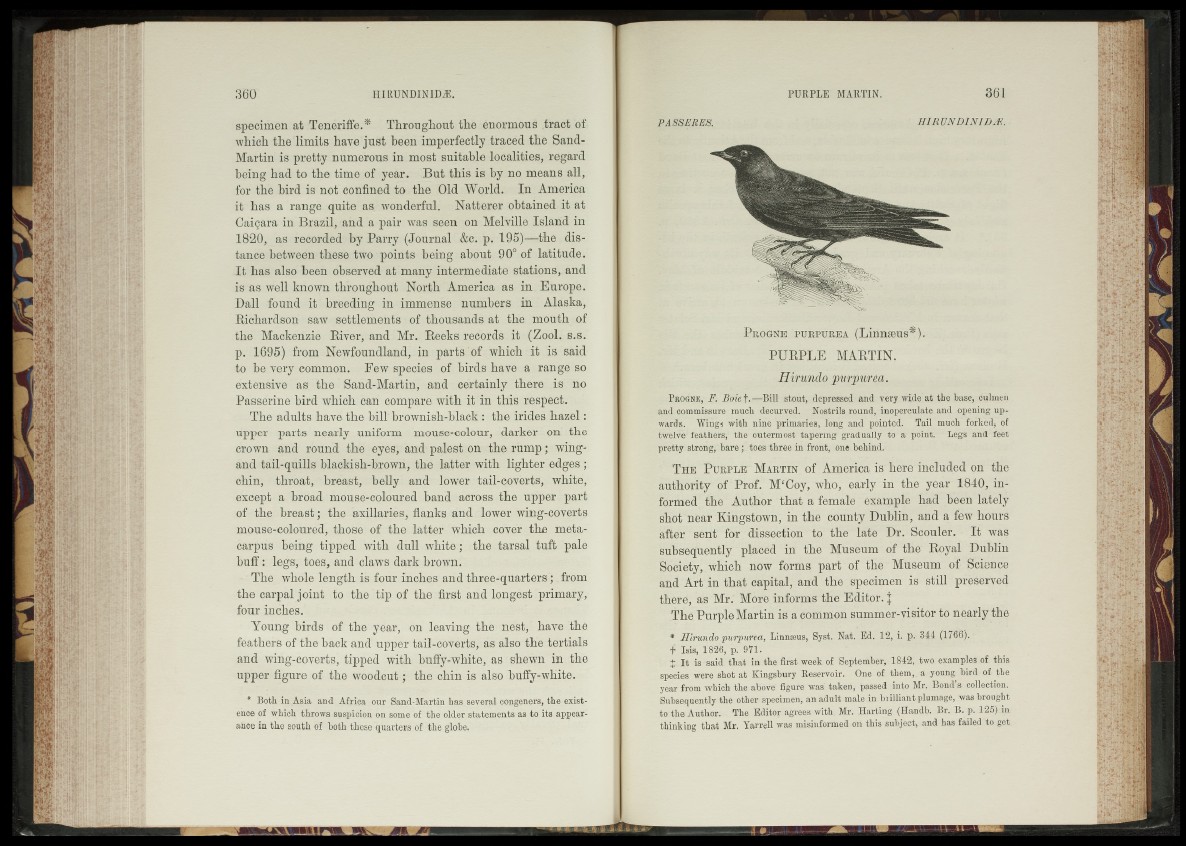
specimen at Teneriffe.* Throughout the enormous .tract of
which the limits have just been imperfectly traced the Sand-
Martin is pretty numerous in most suitable localities, regard
being had to the time of year. But this is by no means all,
for the bird is not confined to the Old World. In America
it has a range quite as wonderful. Natterer obtained it at
Cai§ara in Brazil, and a pair was seen on Melville Island in
1820, as recorded by Parry (Journal &c. p. 195)—the distance
between these two points being about 90° of latitude.
It has also been observed at many intermediate stations, and
is as well known throughout North America as in Europe.
Dali found it breeding in immense numbers in Alaska,
Richardson saw settlements of thousands at the mouth of
the Mackenzie River, and Mr. Reeks records it (Zool. s.s.
p. 1695) from Newfoundland, in parts of which it is said
to be very common. Few species of birds have a range so
extensive as the Sand-Martin, and certainly there is no
Passerine bird which can compare with it in this respect.
The adults have the bill brownish-black : the irides hazel:
upper parts nearly uniform mouse-colour, darker on the
crown and round the eyes, and palest on the rump; wing-
and tail-quills blackish-brown, the latter with lighter edges;
chin, throat, breast, belly and lower tail-coverts, white,
except a broad mouse-coloured band across the upper part
of the breast; the axillaries, flanks and lower wing-coverts
mouse-coloured, those of the latter which cover the metacarpus
being tipped with dull white; the tarsal tuft pale
buff: legs, toes, and claws dark brown.
The whole length is four inches and three-quarters; from
the carpal joint to the tip of the first and longest primary,
four inches.
Young birds of the year, on leaving the nest, have the
feathers of the back and upper tail-coverts, as also the tertials
and wing-coverts, tipped with buffy-white, as shewn in the
upper figure of the woodcut; the chin is also buffy-white.
* Both in Asia and Africa our Sand-Martin has several congeners, the existence
of which throws suspicion on some of the older statements as to its appearance
in the south of both these quarters of the globe.
PASS ERES. H IRU N D IN IDÆ .
P rogne purpurea (Linnaeus*).
PURPLE MARTIN.
Hirundo purpurea.
Progne, F. Boie f .—Bill stout, depressed and very wide at the base, culmen
and commissure much decurved. Nostrils round, inoperculate and opening upwards.
Wings with nine primaries, long and pointed. Tail much forked, of
twelve feathers, the outermost tapering gradually to a point. Legs and feet
pretty strong, bare; toes three in front, one behind.
T h e P u r pl e M artin of America is here included on the
authority of Prof. M‘Coy, who, early in the year 1840, informed
the Author that a female example had been lately
shot near Kingstown, in the county Dublin, and a few hours
after sent for dissection to the late Dr. Seouler. It was
subsequently placed in the Museum of the Royal Dublin
Society, which now forms part of the Museum of Science
and Art in that capital, and the specimen is still preserved
there, as Mr. More informs the Editor. J
The Purple Martin is a common summer-visitor to nearly the
* Hirundo purpurea, Linnaeus, Syst. Nat. Ed. 12, i. p. 344 (1766).
i Isis, 1826, p. 971. 1 I t is said that in the first week of September, 1842, two examples of this
species were shot at Kingsbury Reservoir. One of them,, a young bird of the
year from which the above figure was taken, passed into Mr. Bond s collection.
Subsequently the other specimen, an adult male in brilliant plumage, was brought
to the Author. The Editor agrees with Mr. Harting (Handb. Br. B. p. 125) in
thinking that Mr. Yarrell was misinformed on this subject, and has failed to get